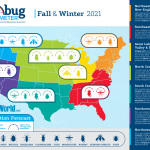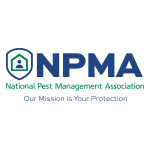Experts Warn of Increased Pest Activity This Fall as Result of Long, Wet Summer

The National Pest Management Association issues its Fall & Winter 2021 Bug Barometer® forecast
FAIRFAX, Va.–(BUSINESS WIRE)–#BugBarometer–The National Pest Management Association (NPMA) today released its bi-annual Bug Barometer® forecast, a seasonal projection of the pest pressure and activity Americans can expect to see in their respective regions of the country based on weather patterns, long-term forecasts and pest biological behaviors. According to the group’s team of entomologists, a mild, wet summer season will spur increased pest activity throughout much of the U.S. as forecasts show looming predictions for a bitter cold winter.
“As much as we all enjoy spending time outdoors and soaking in the summer weather, prolonged periods of warm temperatures throughout the U.S. will heighten pest pressure this fall, allowing stinging insects as well as disease-transmitting pests like ticks and mosquitoes to overstay their welcome in certain regions of the U.S.,” said Jim Fredericks, Ph.D., chief entomologist for the NPMA.
Once temperatures begin to drop, residents across the country should remain vigilant for signs of unwanted invaders and prioritize the necessary prevention measures to keep pests out of their homes. “Much like their human counterparts, rodents and overwintering pests including boxelder bugs and cluster flies will scurry indoors to escape the elements forecasted for the upcoming winter season,” said Fredericks. “While small in size, rodents can spread 35 diseases to humans and are capable of chewing through wood and electrical wires, increasing the risk of electrical fires. As such, it is crucial to work with a licensed pest control professional at the very first sign of an infestation before it gets out of hand.”
Based on this analysis, the National Pest Management Association’s Fall & Winter 2021 Bug Barometer is forecasting an increase in pest pressure across the entire U.S. this season:
Northeast & New England
High temperatures and early rain could allow mosquito and tick populations to thrive well into fall. A bitter winter is expected with colder temperatures and above-average snowfall, which will drive rodents promptly indoors.
Southeast
Cooler conditions in the Southeast are expected to cause warmth seekers such as rodents to hightail it indoors. Above-normal rainfall predictions for Florida could lead to mosquitoes remaining active into early fall.
Great Lakes, Ohio Valley & Midwest
Stinging insect activity will be at its highest during late summer and early fall until temperatures start to drop. Bitter cold temperatures and below-average precipitation predicted this winter may drive rodents indoors early and in search of protection from cold temperatures.
North Central U.S.
The early onset of above-average snowfall in the southern part of this region may drive rodents and overwintering pests including boxelder bugs and cluster flies indoors early in search of shelter. A mild winter may lead to increased tick activity throughout the region.
South Central U.S.
Wet conditions this summer will have allowed mosquito and cockroach populations to thrive. However, early onset of cold conditions could result in a decline in activity. With forecasts calling for colder winter conditions, rodents and overwintering pests including multicolored Asian ladybeetles are expected to move indoors to escape the elements.
Southwest U.S.
Mild, wet conditions this summer with late-season rainfall may allow ants to thrive, prolonging their presence this fall. Relatively cold winter conditions with higher snowfall amounts may drive rodents indoors in search of food and adequate shelter. This may be less of a concern in the Pacific Southwest.
Northwest U.S.
Warm, wet conditions this summer could allow mosquito and tick populations to thrive into the fall months. Cold, dry conditions this winter are likely to drive rodents indoors in search of food, water and shelter. If cooler temperatures are delayed, stinging insect activity could remain high into early fall.
For more information about pests or NPMA’s Bug Barometer® forecast, visit PestWorld.org.
About the National Pest Management Association
The NPMA, a non-profit organization with more than 5,500 members, was established in 1933 to support the pest management industry’s commitment to the protection of public health, food and property from the diseases and dangers of pests. For more information, visit PestWorld.org or follow @PestWorld on Facebook, Twitter, Pinterest and YouTube.
Copyright ©2021 National Pest Management Association
Contacts
Allie Long
[email protected]






